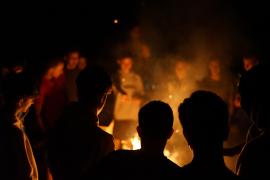At the beginning of my career with youth, I was lucky enough to work in community outreach at a local nonprofit.
Our organization received funding to provide leadership programming and camp experiences to kids who otherwise might not have had access to high-quality youth programs. Our kids were from low-income communities with limited access to transportation, and our funding enabled us to provide community-based youth programming instead of asking young people and their families to come to our location. The organization offered longstanding opportunities for these youth to build on their own leadership skills and to participate in new and exciting experiences, but we had little experience serving this subset of the community.
As we began our outreach efforts, many parents were skeptical of our organization and didn’t want to enroll their kids. They were either unfamiliar with the organization, didn’t feel the program was made for them, or had had a negative experience with a similar program. To help instill trust and build relationships with the community, we intentionally built a staff that was representative of that community. We provided time for staff to immerse themselves in the neighborhoods they served and space for the youth and their families to share their ideas, building a relevant and exciting program alongside one another.
After a few months of intense community building and connecting, we achieved solid attendance and a strong sense of connection in our community-based programs.
With the program established, the next step was to fulfill our promise to provide overnight summer camp experiences to the kids we had been serving.
Preparations
Studies have shown that access to camp is not universally available, and this is especially true for young people who come from families with limited resources (McCombs, Whitaker, & Yoo, 2017). Living in poverty greatly increases the obstacles to participation in developmentally enriching activities such as arts, music, sports, theatre, and summer camp (Masten, 2000). In “Considering Access to Summer Camp,” Jessie Dickerson and Taylor M. Wycoff share, “as access is highly dependent upon family income, and higher-income families are simply able to spend more on these experiences, this gap in spending between families of different socioeconomic status contributes to the widening of the opportunity gap” (Dickerson & Wycoff, 2021).
With the knowledge that access to camp is a barrier for low-income youth, we worked with families to determine what resources and support were needed for their young people to fully participate in a traditional camp experience. Aside from the fact that camp registration is not always financially accessible for every young person, we also found that our supply lists were cost-prohibitive for some families. For a young person who has never been to camp, obtaining a sleeping bag, flashlight, swimwear, towels, and sunscreen, among other items, can cost more than a week’s worth of groceries. For a working family, this is an additional barrier that is often forgotten, even after camp scholarships are given. Thanks to a generous donor, we were able to be very intentional about creating a fun process that allowed our young people to select their own supplies.
We found, too, that many parents had additional reservations about sending their young people to camp. Many caregivers expressed concern about their child’s readiness to be away from home, the camp staff’s cultural competency, and whether the activities would be of interest to their child. Our team spent weeks meeting with families, chatting with them about their concerns, and sharing information about camp to dispel their fears. Many questions arose, among them concerns about the following topics:
- Water safety
- Security
- Sleeping arrangements
- Hygiene
- Social and cultural safety
We were all so excited for the summer to begin once we were able to connect with families and ensure that the kids had what they needed for a full camp experience. The first day of camp arrived as did the bus transportation arranged to pick up the kids in their communities. I drove to camp to meet their bus and make sure the campers had what they needed to ensure a wonderful time.
The excitement showed on their faces in the bus windows, and I was excited as well, hoping they would have an enriching experience.
The Reality
Then one of the kids got off the bus with a blanket instead of the sleeping bag we’d purchased. A camp counselor noticed and said, “Hi, Silly, what are you doing with that blanket? We use sleeping bags at camp!”
The camper’s face fell in embarrassment — their first interaction with camp staff a reminder that they did not have what they needed to fully immerse themselves in the camp experience. A spirit-crushing encounter if ever there was one.
In checking in with the kids throughout the day, more stories confirmed that they felt they did not belong in the camp community.
They shared pool-time struggles. “After we went swimming, no one knew how to help me pull my hair back into a ponytail, and now my hair is so tangled!”
They had issues understanding camp culture. “Everyone was singing camp songs, and we were the only kids who didn’t know the words.”
The food was unfamiliar. The counselors and other campers referred to music, shows, and events they had never seen. And they were pushed into experiences they weren’t ready for in the spirit of “adventure.”
Going away to camp is hard for many campers, but for the young people in our program, the lack of a cultural connection with the staff and other campers added an additional layer of stress.
As outreach staff, we spent so much time trying to get our young people through the door that we had missed an important step in our quest to have an inclusive camp experience: creating a sense of belonging. Additional staff training in the following areas would have been powerful and impactful aids for camp staff:
- Understanding culturally responsive practices
- Exploring unconscious bias
- Learning about the lived experiences of kids from low-income families
- Creating a practice of challenge by choice
- Cultivating a general sense of cultural competence
Victoria Povilaitis, PhD, shares (2017):
Belonging is feeling like you are an accepted, legitimate group member. This feeling is unique to each person and is subjective in nature — one child may feel that they belong in a setting, while another similar (in age, race, gender, etc.) may not feel as if they belong. In addition, while a parent, caregiver, teacher, or youth leader may feel as if a child belongs in a group, that child may have a different perspective, and may not feel as if they “fit in” or belong. While some people may feel like belonging is simply a “want” and that it’s not necessary to be successful in a context, that’s not true. Belonging is a basic human need, and the failure to satisfy a sense of belonging in youth may lead to complications down the line, in adult life . . . . Once an individual feels a sense of belonging, a base has been created and the young person can develop emotional competence, self-regulation, a growth mindset, perseverance, and future orientation.
Young People Speak Up
Recently, I had the pleasure of attending a conference where I heard from a panel of young people about how challenging finding a sense of belonging has been in their youth programs. These young folks were part of a study that drew on the principles of Youth Participatory Action Research, where youth use their own experiences to create questions about an issue that affects them directly, conduct research, and engage in the process to share findings and recommendations. For this project, student researchers conducted surveys and focus groups with intentions of learning:
- More about equitable out-of-school-time (OST) programming
- How young people experience barriers to participation in youth programs
- Young people’s perspectives on OST programming
- Hopes for the future of OST programs
The research team included four university advisors and eleven high school and college students. According to their report from the Wallace Foundation, “A majority of survey respondents had either personally faced barriers that prevented them from joining an OST program or knew of someone who had. This experience was more common for youth of Color than for White youth. Approximately 45 percent of respondents said they had sometimes been treated differently than others in an OST program because of their race, ethnicity, gender identity, sexuality, or religion. Nearly two-thirds of Black respondents said they had sometimes been treated differently” (The Wallace Foundation, 2022).
Here are a couple of key themes that came from focus groups that were conducted with youth from across the nation:
- Young people experience barriers to access: The study found that there are many reasons why a young person would have a hard time attending camp, including:
- Unequitable distribution of programs in their community
- Admissions criteria that excluded young people based on their ability to pay
- Adults and peers who acted as gatekeepers and did not share information about the availability of programs in their community (We saw this with our program, as many people in the community we served had no idea there was a local camp available to them, because information about camp opportunities wasn’t shared in spaces and places they frequented in their daily lives.)
- Young people value a strong sense of community: The student researchers found that young people felt that “an inclusive, humanizing atmosphere is a more important factor in their decision to participate in an OST program than the activities or learning opportunities the program offers” (The Wallace Foundation, 2022). This also means that programs that promote a culture of exclusivity inhibit their ability to join or return to programs. This reminds me of many first-time campers’ experiences with camp songs. The kids we served felt excluded when songs were sung without context and when staff just expected everyone to come to camp with the same background knowledge about singing at camp.
From their observations, the student researchers had a couple of recommendations for youth programs to create more access and build a culture of belonging:
Be intentional about building time, capacity, and funding for outreach, including marketing and advertising, particularly in neighborhoods and communities that typically experience barriers to participation. That way, young people don’t have to rely on word of mouth to learn about your camp. Make sure your staff is working with families, caregivers, and other community organizations to provide resources that minimize common barriers to participation, including lack of transportation and camp supplies or inability to pay program fees.
Create a staff culture of learning, and train program leaders and staff on topics important to students, including:
- Anti-racism, gender, and sexuality
- How to build positive relationship between campers and staff
- How to create youth-led spaces
Take time before campers arrive to identify and eliminate staff behaviors within programs that mistreat and exclude racial minorities and marginalized youth, be it simple social exclusion or overt discrimination.
Make sure that your staff training plan includes ways to build common ground and address exclusion and discrimination between campers (The Wallace Foundation, 2022).
The goal is to make sure the smiles on the kids’ faces when they arrive on the bus remain happily affixed there when they get off the bus.
Photos courtesy of Maine Teen Camp, Porter, ME; Andrew "Doc" Session Community Center Fort Worth, TX.
References
Dickerson, J. & Wycoff, T. M. (2021, September). Considering access to summer camp. Camping Magazine. ACAcamps.org/article/camping-magazine/considering-access-summer-camp
Masten, A. S. (2000). Children who overcome adversity to succeed in life. University of Minnesota | Extension. moodwatchers.com/wp/wp-content/uploads/2012/07/Children-Who-Overcome-Adversity-to-Succeed-in-Life.pdf
McCombs, J. S., Whitaker, A. A., & Yoo, P. Y. (2017). The value of out-of-school time programs. RAND Corporation. rand.org/pubs/perspectives/PE267.html
Povilaitis, V. (2017, November 14 ). Social belonging for youth success — research and promising practices, part 1: What do we know? American Camp Association. ACAcamps.org/blog/social-belonging-youth-success-research-promising-practices-part-1-what-do-we-know
The Wallace Foundation. (2022, April). Youth perspectives on designing equitable out-of-school-time programs. Wallace. wallacefoundation.org/knowledge-center/pages/youth-perspectives-on-designing-equitable-out-of-school-time-programs.aspx
Christen Peterson, CYC-P, is a grants and inclusion manager with the American Camp Association.



